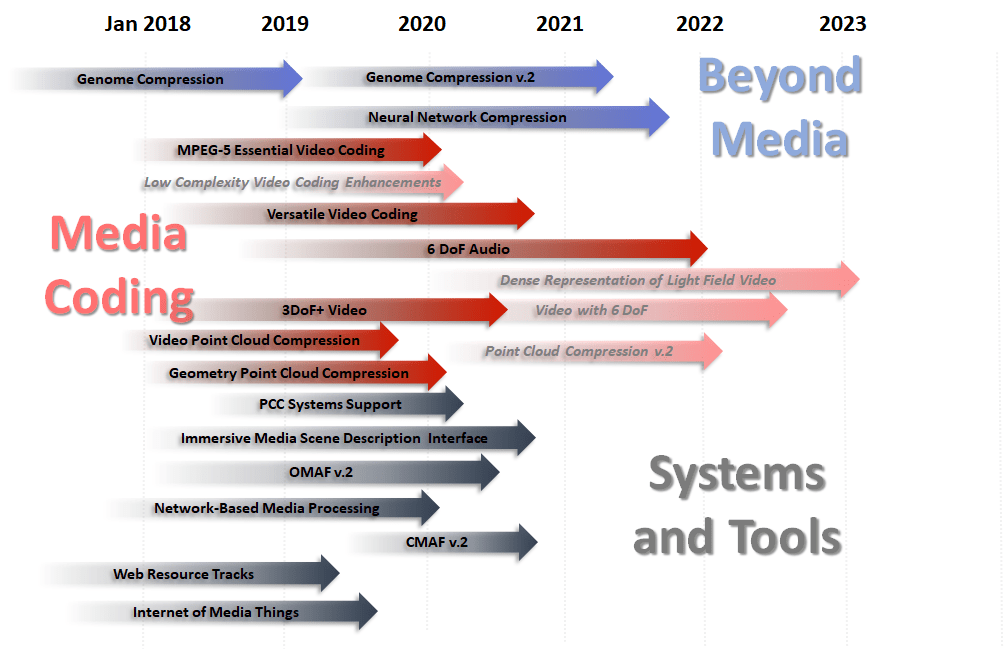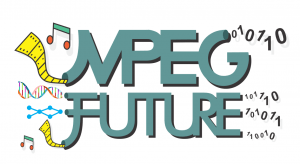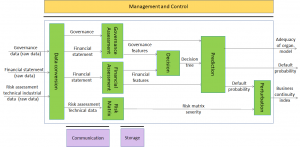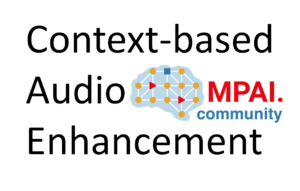Introduction
If I exchange words with taxi drivers in a city somewhere in the world, one of the questions I am usually asked is: “where are you from?”. As I do not like straight answers, I usually ask back “where do you think I am from?” It usually takes time before the driver gets the information he asked for. Then the next question is: “what is your job?”. Again, instead of giving a straight answer, I ask the question: “do you know MPEG?” Well, believe it or not, 9 out of 10 times the answer is “yes”, often supplemented by an explanation decently connected with what MPEG is.
Wow! Do we need a more convincing proof that MPEG has conquered the minds of the people of the world?
The interesting side of the story, though, is that, even if the name MPEG is known by billions of people, it is not a trademark. Officially, the word MPEG does not even exist. When talking to ISO you should say “ISO/IEC JTC 1/SC 29/WG 11” (next time, ask your taxi driver if they know this letter soup). The last insult is that the mpeg.org domain is owned by somebody who just keeps it without using it.
Should all this be of concern? Maybe for some, but not for me. What I have just talked about is just one aspect of what MPEG has always been. Do you think that MPEG was the result of high-level committees made of luminaries advising governments to take action on the future of media? You are going to be disappointed. MPEG was born haphazardly (read here, if you want to know how). Its strength is that it has been driven by the idea that the epochal transition from analogue to digital should not become another PAL-SECAM-NTSC or VHS-Betamax trap.
In 30 years MPEG has grown 20-fold, changed the way companies do business with media, made music liquid, multiplied the size of TV screens, brought media where there were stamp-size displays, made internet the primary delivery for media, created new experiences, shown that its technologies can successfully be applied beyond media…
There is no sign that its original driving force is abating, unless… Read until the end if you want to know more.
What did MPEG do?
MPEG-1 & MPEG-2
MPEG was the first standards group that brought digital media to the masses. In the 2nd half of the 1990’s the MPEG-1 and MPEG-2 standards were converted to products and services as the list below will show (not that the use of MPEG-1 and MPEG-2 is confined to the 1990’s).
- Digital Audio Broadcasting: in 1995, just 3 years after MPEG-1 was approved, DAB services began to appear in Europe with DAB receivers becoming available some time later.
- Portable music: in 1997, 5 years after MPEG-1 was approved, Saehan Information Systems launched MPMan, probably the first portable digital audio player for the mass market that used MP3. This was followed by a long list of competing players until the mobile handset largely took over that function.
- Video CD: in the second half of the 1990’s VCD spread especially in South East Asia until the MPEG-2 based DVD, with its superior quality, slowly replaced it. It uses all 3 parts of MPEG-1 (layer 2 for audio).
- Digital Satellite broadcasting: in June 1994 DirecTV launched its satellite TV broadcasting service for the US market, even before MPEG released the MPEG-2 standard in November of that year! It used MPEG-2 and its lead was followed by many other regions who gradually converted their analogue broadcast services to digital.
- Digital Cable distribution: in 1992 John Malone launched the “500-channel” vision for future cable services and MPEG gave the cable industry the means to make that vision real.
- Digital Terrestrial broadcasting:
- In 1996 the USA Federal Communications Commission adopted the ATSC A/53 standard. It took some time, however, before wide coverage of the country, and of other countries following the ATSC standards, was achieved.
- In 1998 the UK introduced Digital Terrestrial Television (DTT).
- In 2003 Japan started DTT services using MPEG-2 AAC for audio in addition to MPEG-2 Video and TS.
- DTT is not deployed in all countries yet, and there are regularly news of a country switching to digital, the MPEG way of course.
- Digital Versatile Disc (DVD): toward the end of the 1990’s the first DVD players were put to market. They used MPEG-2 Program Stream (part 1 of MPEG-2) and MPEG-2 Video, and a host of audio formats, some from MPEG.
MPEG-4
In the 1990s the Consumer Electronics industry provided devices to the broadcasting and telecom industries. and devices for package media. The shift to digital services called for the IT industry to join as providers of big servers for broadcasting and interactive services (even though in the 1990’s the latter did not take off). The separate case of portable audio players provided by startups did not fit the established categories.
MPEG-4 played the fundamental role of bringing the IT industry under the folds of MPEG as a primary player in the media space.
- Internet-based audio services: The great original insight of Steve Jobs and other industry leaders transformed Advanced Audio Coding (AAC) from a promising technology to a standard that dominates mobile devices and internet services
- Internet video: MPEG-4 Visual, with the MP4 nickname, did not repeat the success of MP3 for video. Still it was the first example of digital media on the internet as DivX (a company name). Its hopes to become the streaming video format for the internet were dashed by the licensing terms of MPEG-4 Visual, the first example of ill-influence of technology rights on an MPEG standard
- Video for all: MPEG-4 Advanced Video Coding (AVC) became a truly universal standard adopted in all areas and countries. Broadcasting, internet distribution, package media (Blu-ray) and more.
- Media files: the MP4 File Format is the general structure for time-based media files, that has become another ubiquitous standard at the basis of modern digital media.
- Advanced text and graphics: the Open Font Format (OFF), based on the OpenType specification, revised and extended by MPEG, is universally used.
MPEG-7
- Media production and archiving metadata: are satisfied by the MPEG-7 AudioVisual Description Profile (AVDP), developed with participation of the broadcasting industry.
MPEG-A
- Format for encrypted, adaptable multimedia presentation: is provided by the Common Media Application Format (CMAF), a format optimised for large scale delivery of protected media with a variety of adaptive streaming, broadcast, download, and storage delivery methods including DASH and MMT.
- Interoperable image format: the Multi-Image Application Format (MIAF) enables precise interoperability points for creating, reading, parsing, and decoding images embedded in HEIF.
MPEG-B
- Generic binary format for XML: is provided by Binary format for XML (BiM), a standard used by products and services designed to work according to ARIB and DVB specifications.
- Common encryption for files and streams: is provided by Common Encryption (CENC) defined in two MPEG-B standards – Part 7 for MP4 Files and Parts 9 for MPEG-2 Transport Stream. CENC is widely used for the delivery of video to billions of devices capable to access internet-delivered stored files, MPEG-2 Transport Syteam and live adaptive streaming.
MPEG-H
- IP-based television: MPEG Media Transport (MMT) is the “transport layer” of IP-based television. MMT assumes that delivery is achieved by an IP network with in-network intelligent caches close to the receiving entities. Caches adaptively packetise and push the content to receiving entities. MMT has been adopted by the ATSC 3.0 standard and is currently being deployed in countries adopting ATSC standards and also used in low-delay streaming applications.
- More video compression, siempre!: has been provided by High Efficiency Video Coding (HEVC), the AVC successor yielding an improved compression up to 60% compared to AVC. Natively, HEVC supports High Dynamic Range (HDR) and Wider Colour Gamut (WCG). However, its use is plagued by a confused licensing landscape as described, e.g. in A crisis, the causes and a solution
- Not the ultimate audio experience, but close: MPEG-H 3D Audio is a comprehensive audio compression standard capable of providing very satisfactory immersive audio experiences in broadcast and interactive applications, It is part of the ATSC 3.0 standard.
- Comprehensive image file format: High Efficiency Image File Format (HEIF) is a file format for individual HEVC-encoded images and sequences of images. It is a container capable of storing HEVC intra-images and constrained HEVC inter-images, together with other data such as audio in a way that is compatible with the MP4 File Format. HEIF is widely used and supported by major OSs and image editing software.
MPEG-DASH
Streaming on the unreliable internet: Dynamic Adapting Streaming on HTTP (DASH) is the widely used standard that enables a media client connected to a media server via the internet to obtain instant-by-instant the version, among those available on the server, that best suites the momentary network conditions.
What is MPEG doing now?
In the preceding chapter I singled out only MPEG standards that have been (and often still continue to be) extremely successful.
I am unable to single out those that will be successful in the future ?, so the reasonable thing to do is to show the entire MPEG work plan

At the risk of making the wrong bet ?. let me introduce some of the most high profile standards under development, subdivided in the three categories Media Coding, Systems and Tools, and Beyond Media. But you have better become acquainted with all ongoing activities. In MPEG sometimes the last become the first.
Media Coding
- Versatile Video Coding (VVC): is the flagship video compression activity that will deliver another round of improved video compression. It is expected to be the platform on which MPEG will build new technologies for immersive visual experiences (see below).
- Enhanced Video Coding (EVC): is the shorter term project with less ambitious goals. EVC is designed to satisfy urgent needs from those who need a standard with a less complex IP landscape
- Immersive visual technologies: investigations on technologies applicable to visual information captured by different camera arrangements are under way, as described in The MPEG drive to immersive visual experiences.
- Point Cloud Compression (PCC): refers to two standards capable of compressing 3D point clouds captured with multiple cameras and depth sensors. The algorithms in both standards are lossy, scalable, progressive and support random access to point cloud subsets. See The MPEG drive to immersive visual experiences for more details.
- Immersive audio: MPEG-H 3D Audio supports a 3 Degrees of Freedom or 3DoF (yaw, pitch, roll) experience at the movie “sweet spot”. More complete user experiences, however, are needed, i.e. 6 DoF (adding x, y, z). These can be achieved with additional metadata and rendering technology.
Systems and Tools
- Omnidirectional media format: Omnidirectional Media Application Format (OMAF) v1 is a format supporting the interoperable exchange of omnidirectional (VR 360) content for a user who can only Yaw, Pitch and Roll their head. OMAF v2 will support some head translation movements. See The MPEG drive to immersive visual experiences for more details.
- Storage of PCC data in MP4 FF: MPEG is developing systems support to enable storage and transport of compressed point clouds with DASH, MMT etc.
- Scene Description Interface: MPEG is investigating the interface to the scene description (not the technology) to enable rich immersive experiences.
- Service interface for immersive media: Network-based Media Processing will enable a user to obtain potentially very sophisticated processing functionality from a network service via standard API.
- IoT when Things are Media Things: Internet of Media Things (IoMT) will enable the creation of networks of intelligent Media Things (i.e. sensors and actuators)
Beyond Media
- Standards for biotechnology applications: MPEG is finalising all 5 parts of the MPEG-G standard and establishing new liaisons to investigate new opportunities.
- Coping with neural networks everywhere: shortly (25 March 2019) MPEG will receive responses to its Call for Proposals for Neural Network Compression as described in Moving intelligence around.
What will MPEG do in the future?
At the risk of being considered boastful, I would think that MPEG should have deserved attention from some of the business schools that study socio-economic phenomena. Why? Because many have talked about media convergence, but they have forgotten that MPEG, with its standards, has actually triggered that convergence. MPEG people know the ecosystem at work in MPEG and I for one see how it is unique.
This has not happened. Let’s say that it is better to be neglected than to receive unwanted attention.
I would also think that a body that started from a Subcommittee on character sets and has become the reference standards group for the media industry, i.e. devices, content, services and applications, worth hundreds of billion USD with potent influences on a nearby industry such as telecommunication, should have suggested standards organisations to study the work method and possibly apply it to other domains.
This has not happened. Let’s say, again, that its is better to be neglected than to receive unwanted attention.
So can we expect MPEG to continue its mission, and apply its technologies and know how to continue delivering compression standards for immersive experiences and new compression standards for other domains?
Maybe this time MPEG will attract attention. So, don’t count on it.
Posts in this thread
- MPEG: what it did, is doing, will do
- The MPEG drive to immersive visual experiences
- There is more to say about MPEG standards
- Moving intelligence around
- More standards – more successes – more failures
- Thirty years of audio coding and counting
- Is there a logic in MPEG standards?
- Forty years of video coding and counting
- The MPEG ecosystem
- Why is MPEG successful?
- MPEG can also be green
- The life of an MPEG standard
- Genome is digital, and can be compressed
- Compression standards and quality go hand in hand
- Digging deeper in the MPEG work
- MPEG communicates
- How does MPEG actually work?
- Life inside MPEG
- Data Compression Technologies – A FAQ
- It worked twice and will work again
- Compression standards for the data industries
- 30 years of MPEG, and counting?
- The MPEG machine is ready to start (again)
- IP counting or revenue counting?
- Business model based ISO/IEC standards
- Can MPEG overcome its Video “crisis”?
- A crisis, the causes and a solution
- Compression – the technology for the digital age
- On my Charles F. Jenkins Lifetime Achievement Award
- Standards for the present and the future



